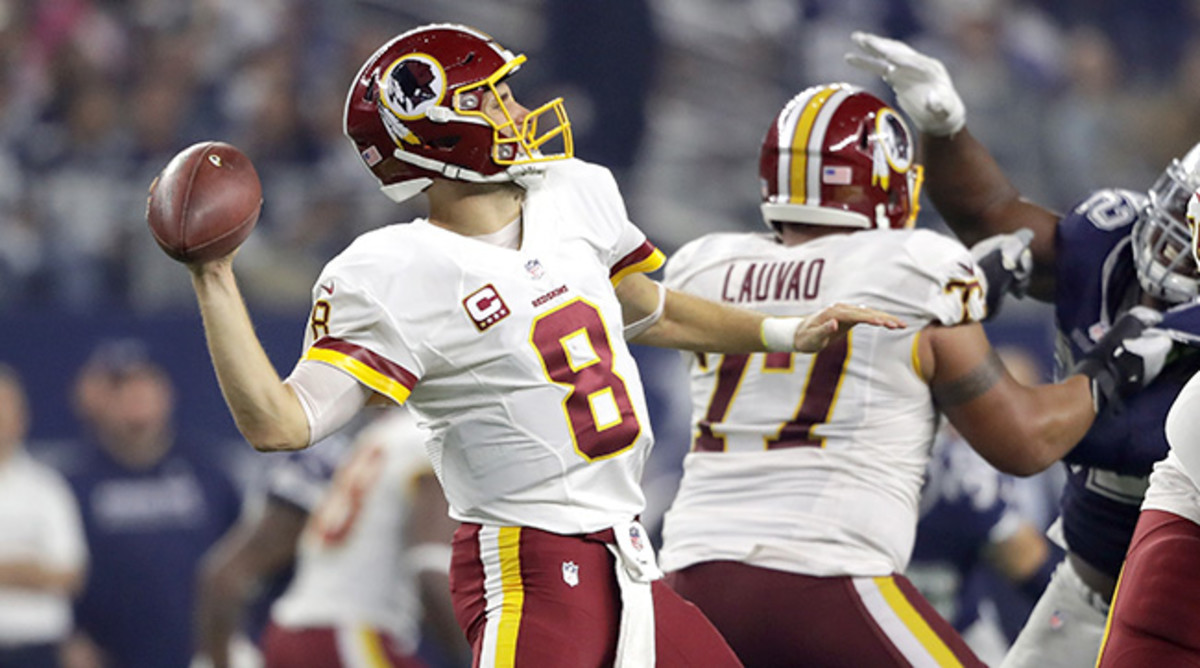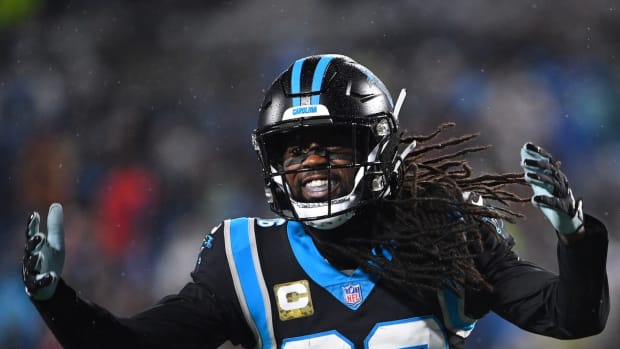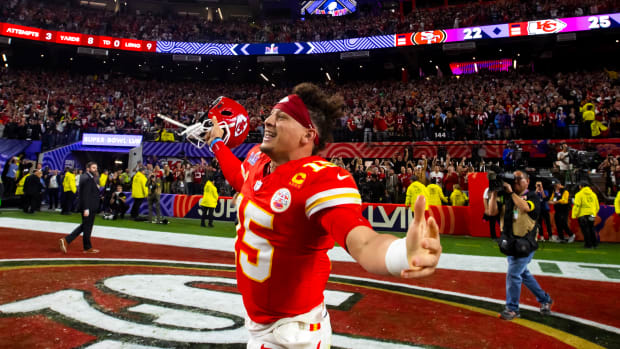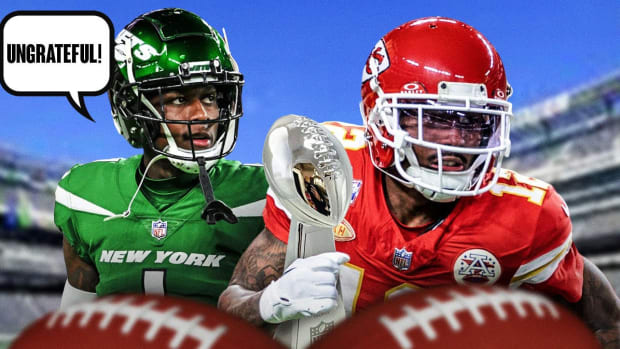One Secret to Kirk Cousins’ Success
Those of you who read these nerdy film study columns regularly know that I’m infatuated with Washington’s offense. It’s a mix of the Patriots’ and Saints’ systems, with a great emphasis on presnap motion and shifting (Patriots) and route combinations that either attack the middle of the field or one side of the field with three receivers (Saints). No offense does a better job of creating favorable angles and matchups for its targets just by where they line up.
A big component of this is Washington’s play-action game. In fact, even though this is, at best, a good-but-not great running team, play-action is Washington’s backbone. (One of the biggest myths in football is that you need a high-quality ground attack in order to have a dangerous play-action game. In reality, you just need a rushing attack where blockers and runners exercise cohesive, repetitive mechanics off the snap.)
Realizing that no offense has been more expansive or aggressive with play-action this season, I had my game-charter (Allan Uy) and numbers guys (Jeff Irwin and Scott Clendening) breakdown Washington’s offense here. What they found was fascinating:
• Kirk Cousins has completed 76.7 percent of his throws on play-action, averaging 11.1 yards an attempt. On non-play-action, Cousins completes 66.7 percent and averages 7.3 yards an attempt.
• Of Washington’s 75 play-action plays, all but one has been what we call “hard” play-action (as opposed to “soft” play-action). With hard play-action, the fake handoff isn’t just a means for setting up a pass play’s timing, it’s a committed, deliberate effort to dupe a linebacker or safety.
• There’s no pattern to who or to where Kirk Cousins throws on play-action. The disbursement is very balanced.
• Forty of Washington’s 74 play-action plays have involved pre-snap motion, and all 40 times, the receiver or tight end has motioned towards the ball, never away from it.
• Only six of the play-action plays have been in shotgun. The rest come from under center.
* * *
* * *
Washington at Arizona
Cardinals: Linebacker Deone Bucannon had wild eyes in the loss at Atlanta and got himself out of position multiple times. You can bet Washington’s play-action game will attack him on Sunday.
* * *
N.Y. Giants at Pittsburgh
Giants: Odell Beckham Jr.’s first touchdown last week came off pre-snap motion, which set up his crossing pattern and eliminated the safety help that Browns corner Joe Haden had been getting all game. Beckham’s 41-yard catch came out of the inside slot position in trips, not his usual outside alignment. His second touchdown was a mix of both these things: pre-snap motion down to the inside slot. We’ve been saying all year: This is how the Giants need to use their superstar receiver.
Steelers: You always hear about Le’Veon Bell’s patience, and for good reason. It’s his best trait. Or maybe it’s his second best trait. Because here’s the thing about patience: You can only play with it if you have the quick, agile burst to compensate when the time comes to make a move. It’s the quick, agile burst that makes Bell special.
* * *
Houston at Green Bay
Texans: When you consider all the coverage disguises and different front-seven alignments, this can be called the most diverse defense in the NFL.
Packers: The tricky question is always whether you blitz Aaron Rodgers or play coverage against him. This year, it seems more defenses are choosing coverage, often rushing three and dropping eight. It makes sense when you consider that Rodgers is so adept at extending plays. If he’s going to extend the play one way or another, you might as well have extra bodies in coverage. The numbers back this up. Against three-man rushes, Rodgers is completing just 51.8 percent of his passes and averaging 5.5 yards an attempt. Against blitzes, Rodgers is completing 62.4 percent and averaging 7.7 yards an attempt.
* * *
Kansas City at Atlanta
Chiefs: Expect to see more three-tight end sets. With Travis Kelce’s insane flexibility and Demetrius Harris’s post-up receiving ability, the Chiefs are uniquely diverse out of what’s typically a run personnel grouping. This season, they’ve gone with three tight ends 79 times. They’ve thrown on a startling 38 of those snaps.
Falcons: Their best defensive player (and maybe the league’s best corner) Desmond Trufant is officially out for the season. His replacement, Jalen Collins, becomes the most important player on this defense. Last week Carson Palmer went after the second-year pro hard down the stretch. Collins glitched but never malfunctioned. He also came up with a few nice stops. Opponents will be studying that film closely.
* * *
Miami at Baltimore
Dolphins: They’re now a run-based offense, though the last two weeks they’ve been stuffed here and Ryan Tannehill has had to carry the day (which he has, brilliantly). They now need one more week of that. Even if offensive linemen Branden Albert and Laremy Tunsil are back healthy, the Dolphins will have trouble running against Baltimore’s dominant front seven.
Ravens: In each of the last two weeks, the Ravens have shown a 1x4 formation near the red zone. This poses great complications for defenses, which are used to sorting out three receivers on one side but rarely four. We’ll likely see more on Sunday. The Dolphins play a lot of zone, which can be severely disrupted by this sort of goofy receiver presnap distribution.
* * *
Buffalo at Oakland
Bills:Kyle Williams is a smart man.
Raiders: This is mostly a “protection first” offense, with emphasis placed on quick throws and extra bodies in pass protection. But last week against the Panthers—who, like the Bills, play a lot of Quarters coverage around the far red zone—Oakland twice spread into an empty set and went “5 verticals,” meaning every receiver ran a Go route. The onus was on the O-line to hold up, and it did, including the first time, when Johnny Holton had a 30-yard near-touchdown.
* * *
Detroit at New Orleans
Lions: The Vikings had great success in the second half on Thanksgiving blitzing Detroit. The Saints last week against Los Angeles consistently sent five rushers after Jared Goff. It’s reasonable to expect defensive coordinator Dennis Allen to again dial up the heat this week against Matthew Stafford.
Saints: A lot of people cited Willie Snead’s 50-yard touchdown pass as the one where Sean Payton was running up the score on his former “co-BountyGate convict” Gregg Williams. But I bet the most satisfying touchdown for Payton was Mark Ingram’s 21-yarder. It came on third-and-17. Williams, who has always liked to bring pressure near the far red zone, went Cover 0 blitz. Quite frankly, it was a bad call from a typically terrific defensive coordinator. A Cover 0 blitz is a risky proposition usually reserved for when you badly need an incompletion. On third-and-17, any completion of 16 yards or less essentially yields the same result as an incompletion: field goal attempt. Anyway, Williams gambled and the Saints were ready. When Ingram left the backfield, nobody covered him (one of the blitzers was supposed to). Coverage bust on a sound Saints play-call.
* * *
Los Angeles at New England
Rams: After watering down the offense for Jared Goff in his first NFL start two weeks ago (the loss to Miami), Los Angeles opened things back up, feeding Goff much of their playbook against the Saints. That in and of itself was a great sign. Jeff Fisher and O coordinator Rob Boras seem to be pleased with the rookie’s early development.
Patriots: Don’t be surprised if Eric Rowe shadows Kenny Britt. The lanky ex-Eagles corner has seen more and more playing time, often taking the opponent’s biggest wideout.
* * *
Denver at Jacksonville
Broncos: Losing fullback Andy Janovich really hurts. He was an integral part of Denver’s base ground game.
Jaguars: You probably haven’t heard Malik Jackson’s name a lot lately. The ex-Bronco has had a solid season, showing the swift lateral movement and strength that made him rich in free agency. His best position is probably five-technique (aligned over the offensive tackle), but he’s mostly played three-tech for the Jags (aligned between the tackle and guard).
* * *
San Francisco at Chicago
49ers: Colin Kaepernick is playing calmer and seeing the field better under Chip Kelly. He still has plenty of room to grow, of course. The complicating factor is Kaepernick might not be a precise enough passer for it to ultimately matter.
Bears: Fifth-round rookie tailback Jordan Howard is very comfortable running to the edge. San Francisco must be prepared to see pitches, sweeps and longer-developing “counter” runs on Sunday.
* * *
Philadelphia at Cincinnati
Eagles: Left tackle Jason Peters could be nearing his end. At 34, he’s clearly not the athlete he once was. Fortunately for him, the Bengals don’t have a pass rushing threat on the right-hand side of the defense (Michael Johnson is well-built but rarely impactful).
Bengals: Last week, this defense suffered blown assignments and bouts of just poor execution when, instead of their staple two-high coverages, they had just one deep safety. Don’t be surprised if coordinator Paul Guenther plays Cover 2 or Cover 4 virtually all game this week.
* * *
Tampa Bay at San Diego
Buccaneers: Second-round rookie Noah Spence has been showing up more and more on film. He’s an athlete and plays with great effort.
Chargers: This offense loves crossing patterns, but those don’t work as well against pure zone defenses like Tampa Bay. Expect to see receivers, most notably Antonio Gates, running hook, sit and curl routes in the middle of the field.
* * *
Carolina at Seattle
Panthers: The fascinating part of Ted Ginn’s 88-yard touchdown at Oakland was that on the throw, Cam Newton’s mechanics—especially his feet—were awful. And yet it was a perfect ball. Wonder what a QB coach tells his student here.
Seahawks: In the past, their trouble against Carolina’s offense has come on vertical route combinations that out-leverage their base Cover 3 principles. Will that encourage D coordinator Kris Richard to call more man coverage? Richard has done that at other times this season….
* * *
Indianapolis at N.Y. Jets
Colts: Chuck Pagano and defensive coordinator Ted Monachino like to blitz. But last week, the Patriots frequently rushed three and dropped eight against the Jets, which is a great way to defend their quick-strike game and make Ryan Fitzpatrick hold the ball (the longer he does, the shakier he gets). Copycatting would be wise here.
Jets: Brandon Marshall drew no special attention from New England (perhaps because it wasn’t as necessary given the emphasis on eight-man coverage?). It’s hard to envision Vontae Davis not traveling with the 11th-year wideout, though. Davis, with his physical style, is well-suited for defending Marshall.
* * *
Dallas 17, Minnesota 15
Cowboys: Dak Prescott’s mobility was the biggest factor in the game, not just on his own runs, but also some of Ezekiel Elliott's. The reason Jason Witten was able to work up to the linebacker level on Elliott's 30-yard run in the fourth quarter was the threat of a Prescott bootleg holding the defensive end on that side.
Vikings: There isn’t a better boundary corner in the NFL right now than Xavier Rhodes.
* * *
Bye-Week Teams
Titans: Marcus Mariota has 46 completions of 20 yards or more this season, fourth most in the NFL. Twenty-two of those completions have come on first down.
Browns: This defense has no genuine pass-rushing threat along its front four. Next to quarterback, that’s the most urgent item to address this offseason. Rookies Emmanuel Ogbah and Carl Nassib are intriguing players, but neither has the quickness nor flexibility of a pure NFL pass rusher.
For daily film study notes, follow @Andy_Benoit
Question or comment? Email us at talkback@themmqb.com.





































